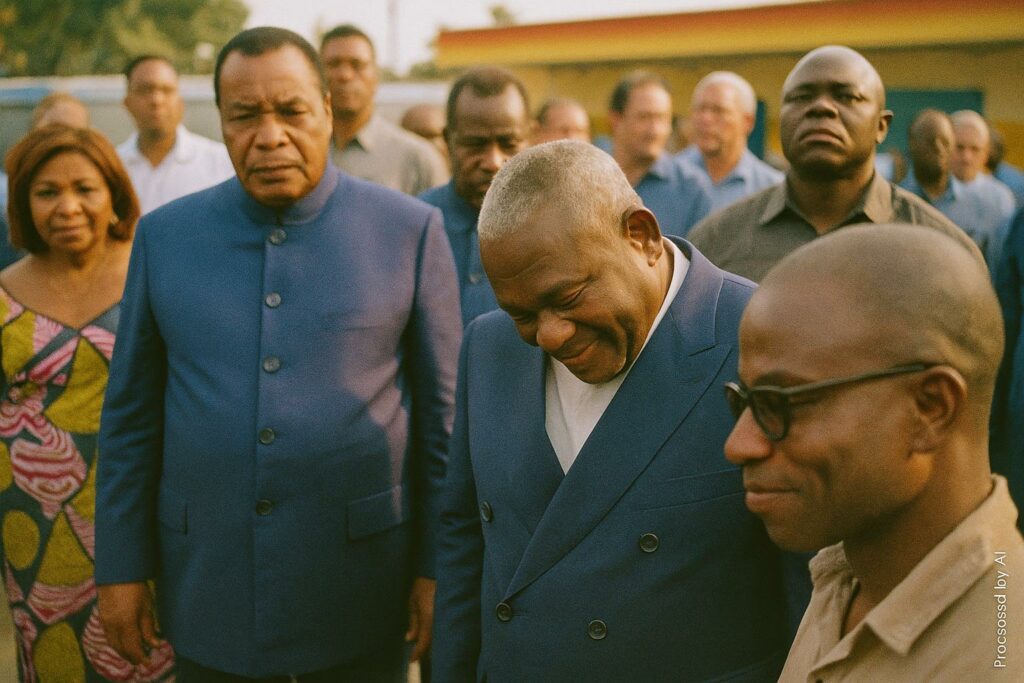A Sudden Presidential Turn on the Boulevard
Motorists heading toward the coastal corniche of Pointe-Noire on 11 July 2025 found themselves sharing the tarmac with an unexpected convoy: President Denis Sassou Nguesso, officially in the city for a private bereavement, chose to leave the discreet circuit of condolence and inspect several construction sites. The unscheduled sortie, accompanied by Prime Minister Anatole Collinet Makosso and the Minister of State for Spatial Planning and Major Works, Jean-Jacques Bouya, immediately drew the attention of local residents who interpreted the passage as a signal that the highest office remains attuned to day-to-day urban concerns.
Symbolism of Pointe-Noire for National Ambitions
Pointe-Noire, Congo-Brazzaville’s commercial nerve centre and key Atlantic outlet, has long encapsulated the country’s aspiration to translate hydrocarbon wealth into diversified growth. Its dynamic port handles more than 85 percent of national trade volume according to Ministry of Economy data, yet until recently a patchwork of deteriorated streets eroded supply-chain efficiency and civic morale. The presidential visit thus echoed earlier commitments within the National Development Plan 2022-2026 to align infrastructure with the region’s strategic stature.
From Ground-Breaking to Paving Stones
The head-of-state first launched the current wave of municipal roadworks on 28 February 2024, releasing entirely domestic funds for the bituminisation, paving and drainage of nearly 70 kilometres of avenues. At Mongo-Mpoukou in the city’s fifth arrondissement, engineers presented progress charts indicating completion rates hovering around 60 percent despite an unusually protracted rainy season (Les Dépêches de Brazzaville, 12 July 2025). On the National Road 4 corridor toward Loango, graders and compactors operated in double shifts to preserve the mid-2026 delivery target.
Fiscal Prudence and Sovereign Financing
Officials accompanying the President stressed that no external borrowing underpins the programme, a point designed to reassure international partners monitoring Congo’s debt-sustainability indicators. The Ministry of Finance reported that 142 billion CFA francs have been disbursed from the 2024 and 2025 budgets, reflecting a deliberate policy to channel petroleum receipts into tangible civic assets rather than recurrent expenditure. Analysts at the Economic and Monetary Community of Central Africa note that this self-financing approach may also strengthen the nation’s negotiating hand in future multilateral dialogues (CEMAC Economic Outlook, April 2025).
Technical Hurdles and On-Site Diagnostics
Concrete culverts awaiting installation lined sections of the boulevard as the presidential motorcade slowed to allow engineers to explain soil-stabilisation challenges unique to Pointe-Noire’s sandy substratum. A senior project supervisor from the Congolese Agency for Major Works conceded that import delays for polymer-modified bitumen had set back certain segments by three weeks, yet insisted that contingency procurement channels had now been secured through Cabinda and Luanda ports. Observers interpreted the President’s pointed questions about material testing protocols as evidence of a governance culture increasingly intolerant of cost overruns.
Urban Mobility and Socio-Economic Multipliers
Beyond engineering metrics, the broader calculus involves reductions in travel time—currently estimated at 40 minutes between downtown Pointe-Noire and Loango—and the stimulation of peri-urban land markets. Local business associations predict a 15 percent rise in small-enterprise turnover once the arterial grid is fully operational, a forecast echoed by preliminary simulations from the World Bank’s Central Africa Infrastructure Diagnostic (May 2025). Improved drainage is also expected to curtail the incidence of seasonal flooding that last year displaced over 3 000 residents in the Tié-Tié district.
Stakeholder Voices from the Edge of the Trench
Standing beside a freshly laid kerbstone, civil engineer Armelle Malonga remarked that direct presidential oversight ‘compresses the distance between policy and execution’. For Mayor Evelyne Tchitchelle, the visit offers political capital to persuade sceptical residents that temporary detours and dust clouds constitute an investment in long-term urban dignity. Meanwhile, a representative of the Pointe-Noire Chamber of Commerce hailed the decision to involve local subcontractors, noting that 62 percent of labour hours have been sourced from within Kouilou.
Regional Connectivity and Diplomatic Resonance
The revitalised National Road 4 dovetails with Congo-Brazzaville’s ambition to serve as a logistical hinge for the wider Gulf of Guinea. By enhancing the artery that feeds into the Pointe-Noire deep-water port—currently under expansion through a public-private partnership—Brazzaville positions itself to capture transit traffic from northern Angola and the southwestern provinces of the Democratic Republic of Congo. Diplomats consulted in the run-up to next month’s Central African Transport Forum argue that visible progress on the ground strengthens the country’s case for additional regional infrastructure compacts.
A Calculated Message of Continuity and Oversight
As the presidential convoy merged back into regular traffic, no formal speech was delivered. Yet the optics alone communicated a layered narrative: development projects remain on schedule, fiscal stewardship is under control, and the executive branch retains hands-on familiarity with local realities. For a polity where perception often rivals policy, such unfiltered moments may bolster public confidence and reassure external partners monitoring reform momentum. In Pointe-Noire, freshly poured asphalt now doubles as a canvas on which the administration sketches its vision of resilient, inclusive growth.

